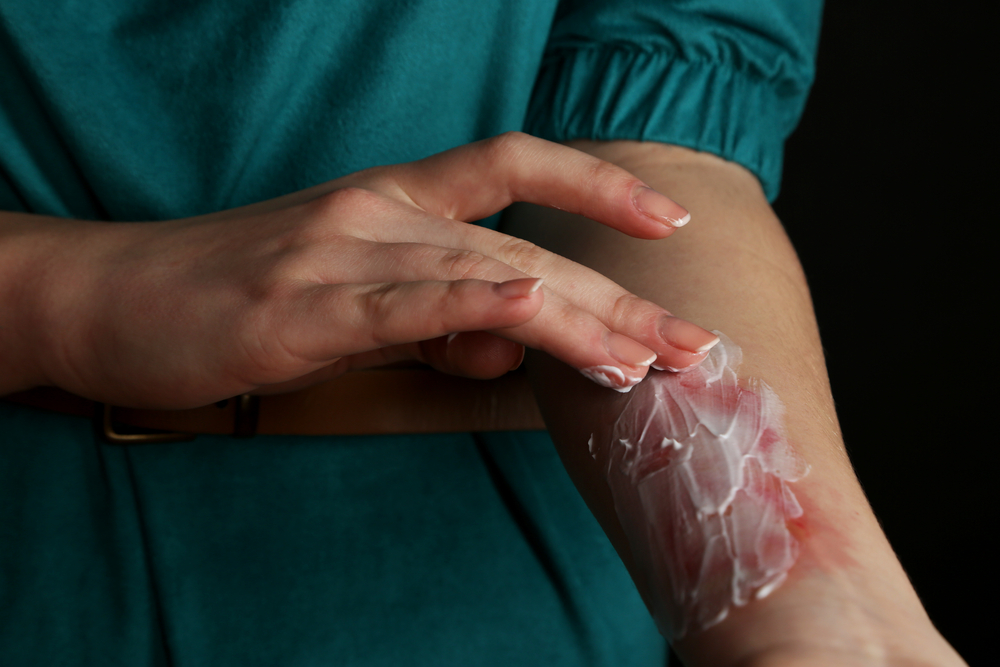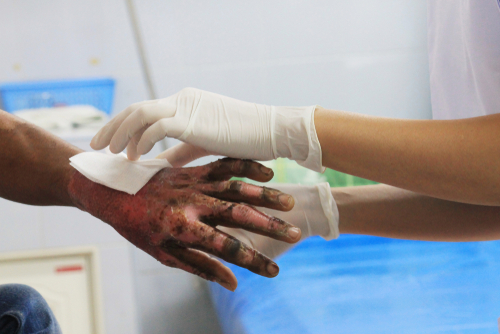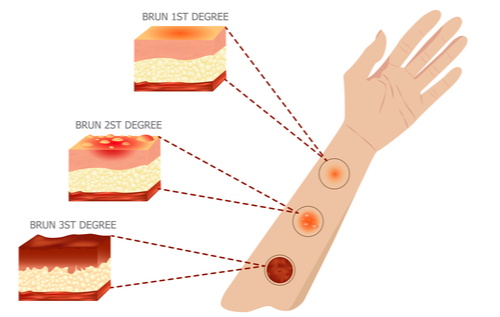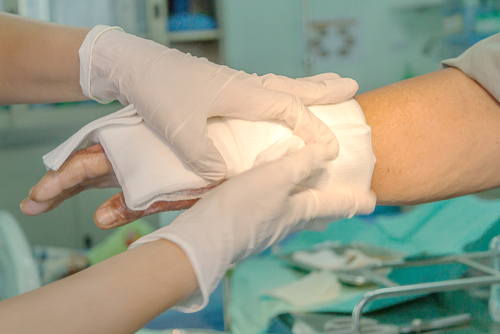In the United States, more than 3 million people receive some type of burn each year.
While most of these burn injuries cannot be classified as a clinical emergency and require little to no treatment, others require advanced medical assistance. It was estimated that ten percent of all burn victims would die due to the injuries suffered.
Every week you will read in the newspaper or see on TV how someone was burned by a house fire or an explosion of some sort. The following article was intended to present the anatomy of burn injuries and basic treatment. We should all know how to assist a burn victim since this knowledge can and will save lives.
Most probable causes for burns
Some of the most common causes of burn injuries are fire, hot metal, scalding hot fluids, or steam. During the hot summer months, people spending their time near the beach or large bodies of water will be affected by the ultraviolet irradiation from the sun, better known as sunburn, which can cause severe skin damage.
Even more, the chemical composition of our atmosphere that has been gradually changing over the last decade leads to more severe sunburns than ever. Scientists believe this change is caused by the emission of ozone-destroying chlorofluorocarbons ozone, a chemical that absorbs ultraviolet radiation from the sun, is thinning.
This allows for more harmful ultraviolet radiation to reach the earth. Since the major cause of skin cancer is the ultraviolet rays of the sun, too much sunburn over a period of time could kill you.
Other burn causes
Mechanical abrasions and electrical current can cause occult or hidden damage and frequently progress in severity after the initial injury. Chemicals such as acids and alkalies are also quite common burns. Alkali burns are usually more severe than acid burns due to alkali lipid penetration and rapid burn depth. This is why alkali burns are more likely to result in a full-thickness burn.
X-ray irradiation, nuclear radiation, dry heat, and severe cold such as that from liquid nitrogen are also causes of burn injuries even though these are not a frequent occurrence.
Burn injuries, especially those caused by an open flame, may be associated with internal injuries not immediately apparent or suspected. People often fail to realize that a burn is more serious than it looks because they can’t actually see the damage.
Heat and toxic fumes can burn and damage the esophagus and lungs. Various synthetics, when burned, give off toxic fumes. Many of your local firefighters can verify this from personal experiences.
Some of the most devastating causes of burns are explosions since they can cause trauma in addition to burns to organs from the combustion.
Along with getting a standard medical history, ask about immunization. This is important because someone with extensive burns will need his immunization status against Clostridium tetani evaluated.
The skin layers
As you will see below, one needs to know how severe a burn is before providing proper assistance to the patient. However, this cannot be done without having some knowledge of the largest human organ, the skin.
The skin is composed of three layers, and knowing how to recognize them will help you figure out how serious the burn is.
Epidermis
This is the outer layer, which is composed of stratified squamous epithelium. This layer provides protection and does not contain blood vessels or lymphatics. The thickness of this layer varies depending on the region of the body. It is thickest on the soles of the feet and palms of the hands
Dermis
This irregularly arranged connective tissue contains nerves and nerve ending, blood vessels, lymphatics sebum and sweat glands, hair follicles, and mammary glands.
Subcutaneous tissue
This layer cannot be considered an actual part of the skin. It contains fibroelastic tissue and fat. It attaches the skin to the muscles and bones
Classification of burns
The first thing you have to do before attempting to treat a burn is to determine its depth. You can classify the burns into three degrees of depth since this will help you better assess the severity of the burn and the possibility of recovery.
First Degree burn injuries
These types of burn usually involve only the epidermis or outer layer of the skin. Such burns are usually caused by sunburn or brief thermal contact as from a mild scald.
At a close clinical inspection, you will notice erythema or red akin, which is painful. This discomfort is present since the nerve elements in the dermis or liner below the epidermis are intact.
Even though first degree burns can be quite painful, on many occasions, such burns will heal on their own without causing scarring. A fever or systemic symptoms are rare unless a large area of the body has been involved.
Most times, no treatment is required except for some mild painkillers or various creams to ease the pain. Before you plan to take any medication, be sure you are not allergic or have a condition that is contraindicated to the medicine.
Second Degree burn injuries
This is also known and probably more correctly so as a partial thickness burn. The epidermis layer and some of the underlying dermis is destroyed.
At a close clinical inspection, you will notice that the skin is red as in a first-degree burn, but in addition, blister formation can be observed on the epidermis and dermis. There is also a weeping surface with swelling. Pain is almost always present and can be slightly decreased depending on the burn’s depth. The burned area can be hypersensitive to even a light touch.
Those with a partial thickness burn are very vulnerable to infection, so you should try to use sterile techniques. Conversion to a full-thickness burn as well as fluid and protein losses can often occur. Skin texture can be normal and firm to the touch.
You need to cover the entire burn area with sterile burn pads. If those are not available, cover the area with a clean dressing, one without a lot of lint that can get into the burn. If you have sterile water available, moisten the dressing.
Next, watch for shock and respiratory problems. Transport the patient to a hospital for medical care.
In most cases, superficial second-degree burns may heal within two weeks with little scarring. If someone was unfortunate to experience a deep partial burn, then four to six weeks may be needed for healing. Scarring here is likely to occur.
The outcome of second-degree burns is generally good provided that there is no infection to add to complications and your nutrition is adequate. Good nutrition plays an important role in wound healing. The healing will be hindered if the patient is in a negative nitrogen balance. This means that your body is using more protein than it is making, a common finding in starvation.
Also, vitamin C and zinc deficiencies, along with chronic corticosteroid therapy, are all implicated in impairing wound healing. Steroids reduce the inflammatory response to an initial injury, which impedes the cleaning of necrotic tissue.
Third Degree burn injuries
These are also known as full-thickness burns and are the most serious of the three.
At a close clinical inspection, you will notice that the burned surface has a charred, waxen, or leathery appearance. Depending on what caused the burn, the skin may appear white, translucent, and dead. The surface is usually dry instead of weeping.
Also, since these types of burns are deep, the nerve elements have been destroyed, and there is no pain. There will be no sensitivity to temperature. Blisters don’t occur.
Care must be provided in the same way as for second-degree burn injuries, and transport to the nearest ER is mandatory. However, this is a true life-threatening emergency. Transportation to a burn center is highly recommended in order to save the patient. By knowing what is available in your area before an emergency arises, you are better able to pick the best facility.
Since all skin layers have been destroyed in third-degree burns, there is no chance for regeneration. Grafting is, therefore, mandatory.
How to establish the surface of the burn
To quickly help the examiner in estimating and assessing the extent of the body area involved, you should be familiar with the standard “rule of nines.” This system divides the body’s surface area into anatomic percentage areas, each of which is 9 percent or a multiple of 9 as 18.
Adult
9 percent for face, scalp, and neck; 9 percent for each arm; 18 percent for each leg, anterior (front), front and back or posterior; 18 percent for chest or back; 1 percent reserved for the perineum.
Child
18 percent for the face, scalp, and neck; 14 percent for each leg
General first aid treatment of burns
What you should keep in mind for partial and full-thickness burns:
- Every burn injury should be treated as a serious burn, even if the damage might not be entirely visible.
- First aid should be provided in order to stabilize the victim before professional medical help arrives.
- You need to remove contaminated and burning clothing. Keep in mind that synthetics often melt and will retain heat. This leads to deeper injuries
- Always cover the burns with a sterile pad and soak them in sterile water if available.
- Do not cover the burns with any type of pads that may stick to the burn and contaminate it.
- Retain yourself from applying spray or ointment on such burns because the hospital physician will have to clean the burn, and you will only make their work harder.
- If you are dealing with a chemical burn, you need to irrigate the wound with cold water continuously until medical care is provided. An exception is alkali burns caused by dry lime. When water mixes with lime, you get a corrosive mixture that burns. If dry, brush it off unless a lot of water is available for rapid and thorough irrigation.
- Electrical burns need special care, and professional medical care should be provided as quickly as possible. These do not appear severe on the surface, but the patient may have extensive internal damage. Even heart damage can occur, and that is not visible and requires EKG monitoring.
- Burns caused by explosions often have associated injuries. You will have to inspect the patient for fractures and laceration and stop the bleeding if present.
- Treat the patient for shock and transport the victim lying flat.
Final words
As in most cases, the best treatment for an injury is prevention. Most people will only experience sunburns during their lifetime, while others may suffer from more severe burns caused by various accidents.
In burn injuries, you can’t do much to treat, but first aid is important, especially in surveying the victim before transport. Learn to identify burns and properly assist or treat a burn victim since you never know when you may have to use this knowledge.
















































































I’m a retired firefighter with 35 yrs experience in Toronto. To reduce the severity and pain, as quickly as possible get the burned area placed under cold water. Ice water if possible. The thinking is this. Energy flows from high temp. to low temp. Placing a limb in cold water allows the heat that is in the cells to flow outward into the cold water. The quicker you get it into the water the less damage because the heat that normally jumps from cell to cell causing damage is reduced rapidly. The result is less pain and less structural damage to your body. Then treat as mentioned above.
Another bit of survival knowledge along the same lines, is a way to manage high core temperatures in your body. Think heat stroke or heat exhaustion. Soak your forearms in cool water. Studies done by both the fire service and the Canadian Coast Guard found that a few minutes with your forearms in cool water dropped your core temperature rapidly. It is now used to manage high core temperature during hot weather firefighting.
Good article. Another first aid trick for burns that I’ve personally witnessed was a young man who was badly burned by falling into hot tar while helping on a road paving project. More than 60% of his body was covered in hot tar that sticks and doesn’t like to come off. A lady who was returning home from the grocery store saw the accident, grabbed the 2 dozen eggs she’s just purchased and separating the egg whites from the yokes, she spread the raw egg whites over as much of this young mans burned body as she could. She started with his face/scalp/neck, then arms/hands and chest. By that time the ambulance arrived. The paramedics told her that the young man would forever be thankful for her knowledge of using egg whites as it is the perfect amniotic fluid and restores skin regrowth like thing else. He came to the hospital where I worked at the time. The areas treated with egg white needed far less treatment and attention and most of all healed scar free or nearly scar free. The areas not treated with raw egg white, back, legs, some portions of the abdomen, were much more difficult and very painful for the patient when treated and they all healed leaving many scars. Before he left the hospital he was able to see the great difference between the portions that had been treated with egg white versus the areas that had not, he said he was going to make it is business to find the lady who cared enough to help him, to thank her. Multiple times since then I’ve used raw egg white to treat sunburn, steam burns, hot metal (kettle) burns, or burns from hot ovens. They have all healed scar free and the pain from the burn quickly dissipates as healing starts immediately.
The best advice of all is what the author wrote: “As in most cases, the best treatment for an injury is prevention.”
I have herd about using “Egg Whites” and it seemed to work quite well. I use 50% Aloe Vera Gel (Food Grade) and 50% Collaidal Silver. Mix in a bottle or jar by using 1/2 Aloe Vera Gel and
1/2 Collaidal Silver. This works quit well. Put it on every few minutes until it quits burning .
I used this after getting burned with steam at work. There is also a save using Silver it works quit well well also. I lived 30 years in Alaska and used it often for burns from welding.